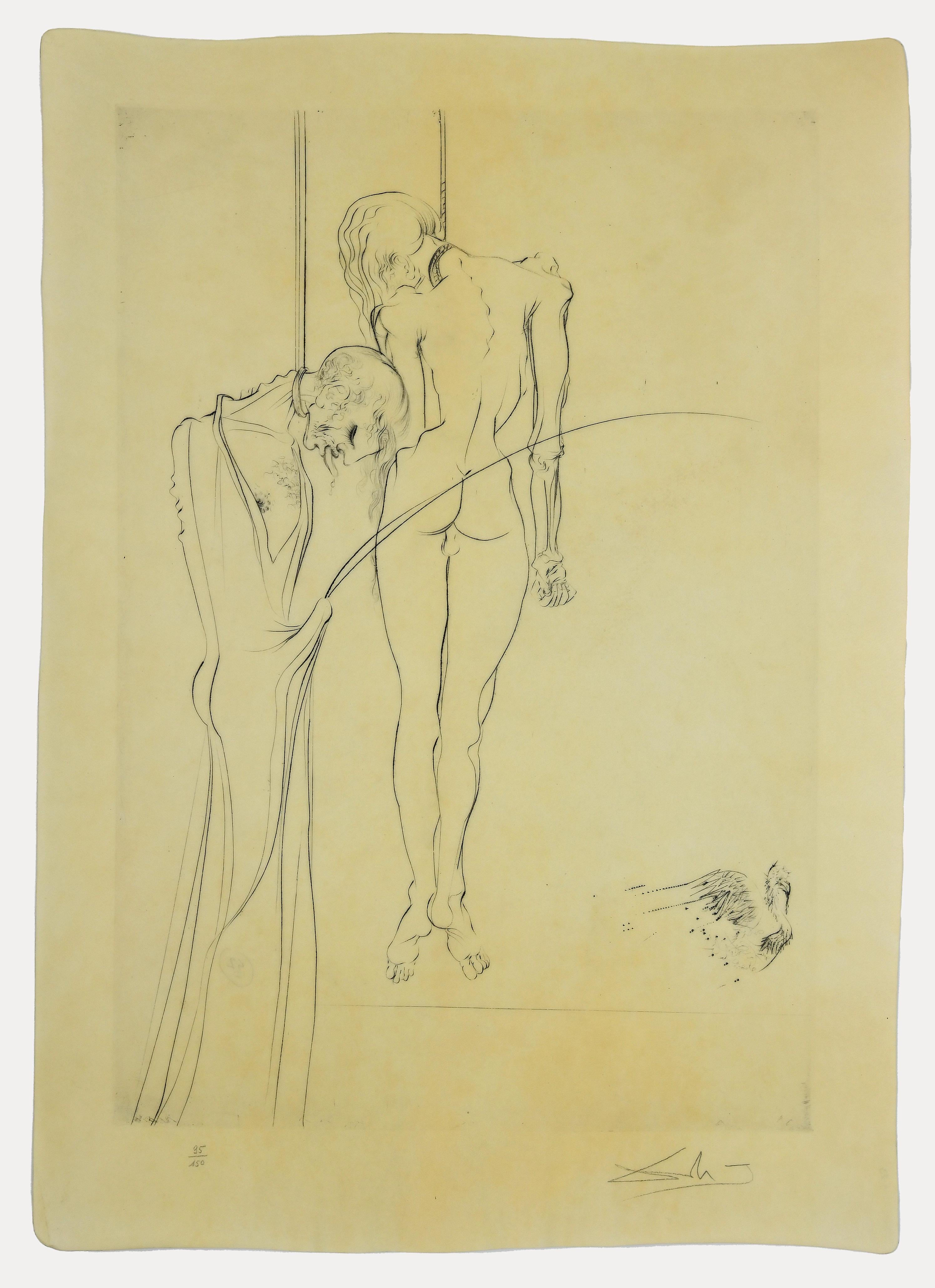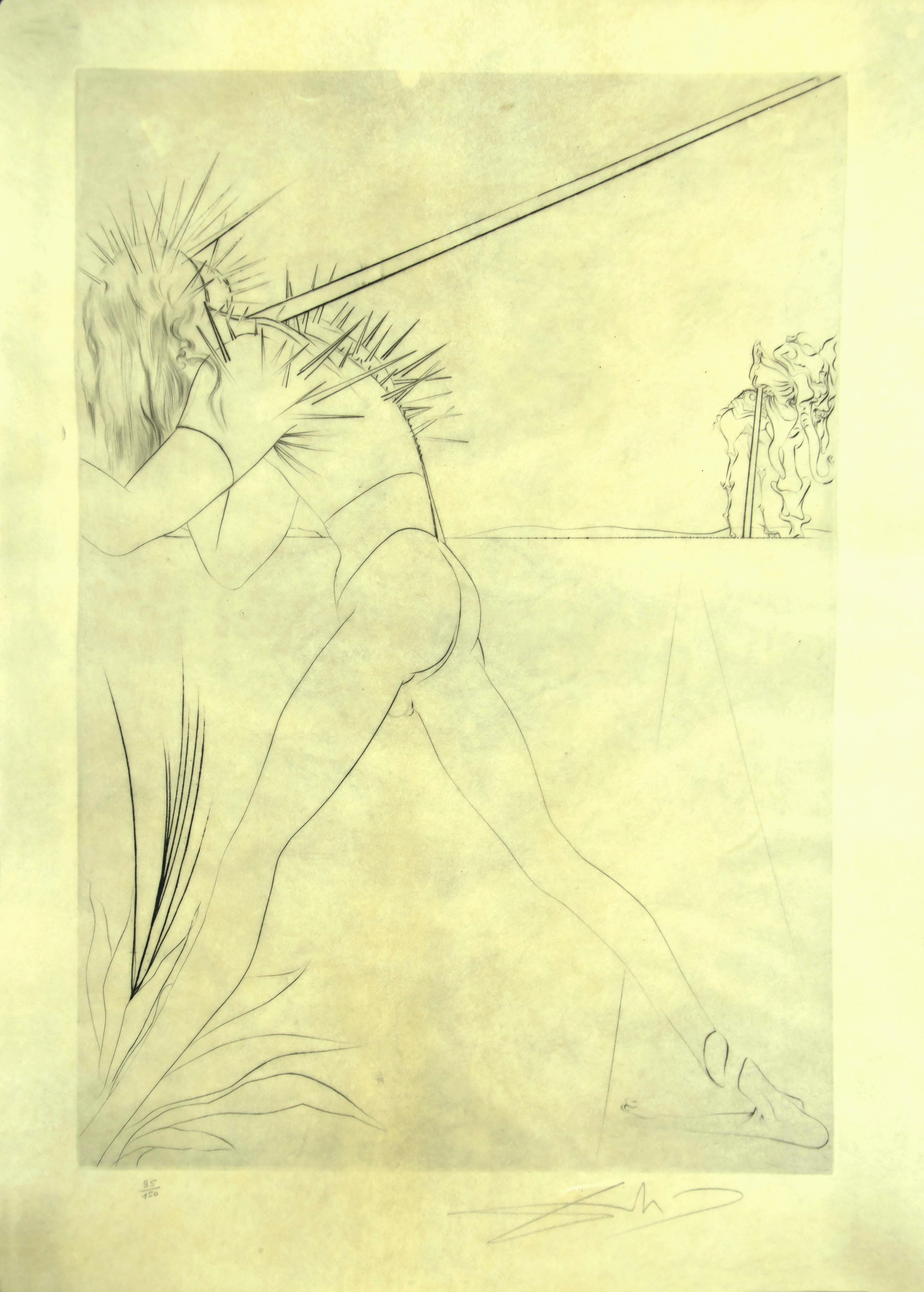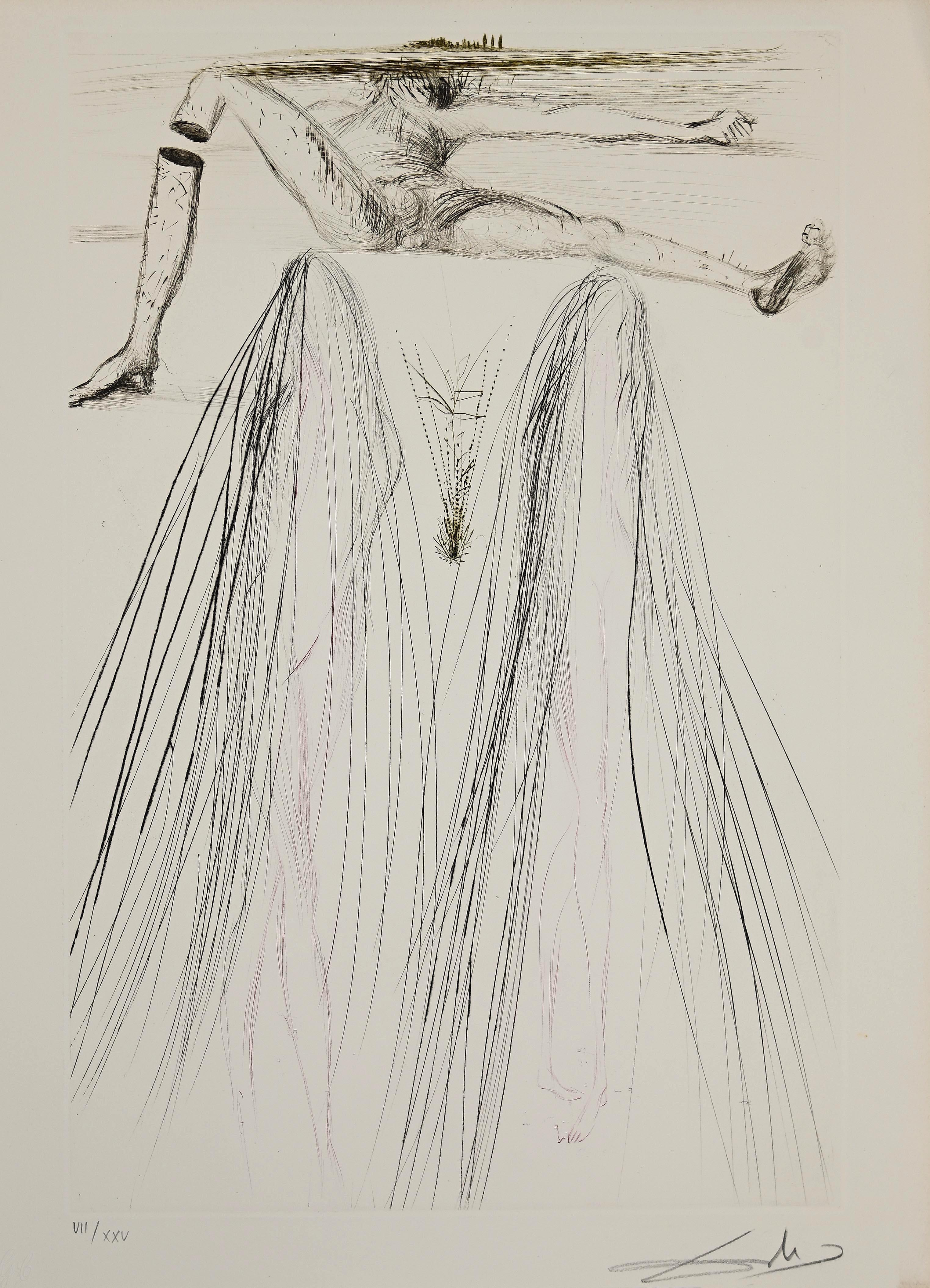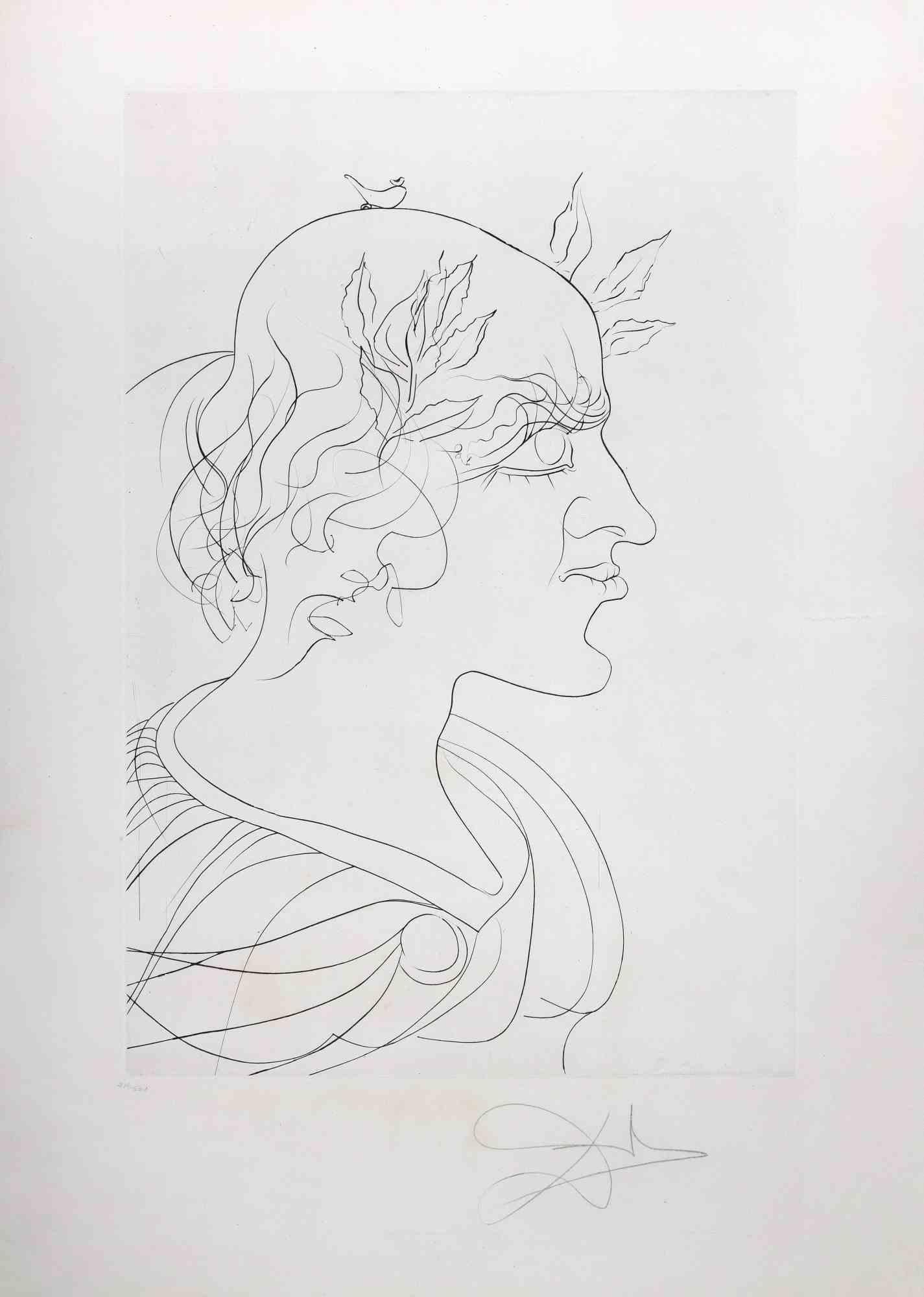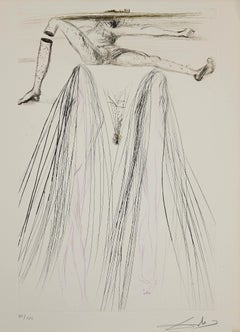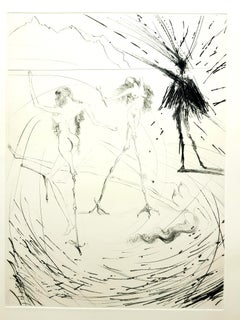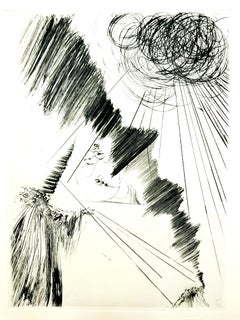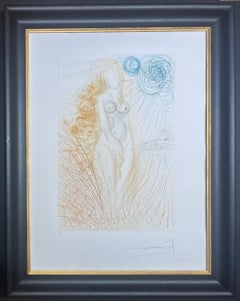Items Similar to Le Testament de Tristan - Drypoint Etching attr. to S. Dalì - 1969
Want more images or videos?
Request additional images or videos from the seller
1 of 8
Le Testament de Tristan - Drypoint Etching attr. to S. Dalì - 19691969
1969
$1,436.23
£1,055.76
€1,200
CA$1,965.03
A$2,194.76
CHF 1,140.46
MX$26,727.71
NOK 14,486.42
SEK 13,650.38
DKK 9,132.53
Shipping
Retrieving quote...The 1stDibs Promise:
Authenticity Guarantee,
Money-Back Guarantee,
24-Hour Cancellation
About the Item
Le Testament de Tristan - From "Tristan et Iseult" is a modern artwork realized in 1969
Colour-printed drypoint etching, from the series of 21 etchings of “ Tristan et Iseult”.
Hand monogrammed by the artist in graphite on lower-right margin.
Includes passepartout: 68 x 48 cm
Italian Edition, Wucua e Grafica Contemporanea: 125 on Lana, of which the first 25 copies contain a signed suite. Dry stamp “G.C.” on the bottom left.
In addition, 3 copies designated “A.C.”
This sheet of the print suite is in perfect condition and with fresh impression. One of the 21 illustrations realised by Salvador Dalí for the print suite of "Tristan and Isolde", published in 1969. Dalí here shows and illustrates in graphics one of his many interpretations of the story of Tristan and Isolde, a very popular 12th-century tale of romance and tragedy of literature, music, and art. The story presents many different variations of the same plot.
Reference: R. Michler, L.W. Lopsinger, Salvador Dalì, Catalogue Raisonné of Etchings and Mixed-Media Prints, 1924-1980, Prestel, 1994, Munich, pag. 184, image n. 415.
Prov.: Pandolfini Auction House
- Attributed to:Salvador Dalí (1904 - 1989, Spanish)
- Creation Year:1969
- Dimensions:Height: 17.72 in (45 cm)Width: 12.41 in (31.5 cm)Depth: 0.08 in (2 mm)
- Medium:
- Movement & Style:
- Period:
- Framing:Framing Options Available
- Condition:Insurance may be requested by customers as additional service, contact us for more information.
- Gallery Location:Roma, IT
- Reference Number:Seller: T-1333421stDibs: LU650310796572
About the Seller
4.9
Platinum Seller
Premium sellers with a 4.7+ rating and 24-hour response times
1stDibs seller since 2017
7,589 sales on 1stDibs
Typical response time: 2 hours
- ShippingRetrieving quote...Shipping from: Roma, Italy
- Return Policy
Authenticity Guarantee
In the unlikely event there’s an issue with an item’s authenticity, contact us within 1 year for a full refund. DetailsMoney-Back Guarantee
If your item is not as described, is damaged in transit, or does not arrive, contact us within 7 days for a full refund. Details24-Hour Cancellation
You have a 24-hour grace period in which to reconsider your purchase, with no questions asked.Vetted Professional Sellers
Our world-class sellers must adhere to strict standards for service and quality, maintaining the integrity of our listings.Price-Match Guarantee
If you find that a seller listed the same item for a lower price elsewhere, we’ll match it.Trusted Global Delivery
Our best-in-class carrier network provides specialized shipping options worldwide, including custom delivery.More From This Seller
View AllDes Rois Pendus aux Arbres - Etching and Drypoint attr. to S. Dalì - 1973
By Salvador Dalí
Located in Roma, IT
Des Rois Pendus aux Arbres (Kings Hanging in the Trees) in an original etching and drypoint realized by S. Dalì in 1973.
It is part of the Series "King, I Sha...
Category
1970s Surrealist Figurative Prints
Materials
Etching
Il y a Des Soldats - Etching attr. to S. Dalì - 1973
By Salvador Dalí
Located in Roma, IT
Il ya a des Soldats (There are Some Soldiers) is an original etching and drypoint realized by Salvador Dalì in 1973. It belongs to the series "Poi, Je t'Attends à Babylone", a suite ...
Category
1970s Surrealist Figurative Prints
Materials
Etching
The Giant Beliagog - Drypoint attr. to S. Dalì - 1969
By Salvador Dalí
Located in Roma, IT
Hand signed. From the deluxe edition of 25 prints in Roman Numerals aside from the standard edition of 125. (There were 4 similarly-numbered editions in English, German, Italian, an...
Category
1960s Surrealist Figurative Prints
Materials
Drypoint
Trajan - Drypoint Etching attr. to Salvador Dalì - 1973
By Salvador Dalí
Located in Roma, IT
Trajan is an original contemporary artwork realized in 1973.
Black and white drypoin etching.
Hand signed on the lower margin.
Numbered on the lower left. Edition of 216/261.
Ref...
Category
1970s Surrealist Figurative Prints
Materials
Etching, Drypoint
Sorcière au Balai - Etching - 1968
By Salvador Dalí
Located in Roma, IT
Sorcière au Balai is a rare artwork from the Series "Faust" (La Nuit de Walpurgis), realized 1968/69.
Etching, Drypoint, Watercolor and Roulette on Japon...
Category
1960s Surrealist Figurative Prints
Materials
Etching
$1,705 Sale Price
25% Off
Filiae Herodiadis Saltatio - Lithograph - 1964
By Salvador Dalí
Located in Roma, IT
Filiae Herodiadis saltatio is a Color lithograph on heavy rag paper realized in 1964. It is part of Biblia Sacra vulgatæ edition is published by Rizzoli-Mediolani between 1967 and 19...
Category
1960s Surrealist Figurative Prints
Materials
Lithograph
You May Also Like
Salvador Dalí (1904-1989) - Drypoint etching on Lana paper - 1970
By Salvador Dalí
Located in Varese, IT
Drypoint etching on Lana paper, edited in 1970.
Limited edition of 175 copies, numbered as 150/175 in lower left corner.
Hand-signed by artist in pencil in the lower right corner.
Paper size: 76 x 56 cm
Framed size: 94,5 x 78 cm
Very good conditions.
Bibliography: Dalì - Catalogue Raisonnè of Etchings and Mixed-Media Prints, 1924-1980 Ref. 452
A regular certificate of authenticity and publication will be included. Also placed on the back is the original certificate hand-signed by Salvador Dali...
Category
1970s Surrealist Prints and Multiples
Materials
Paper, Etching
Salvador Dali - Women - Original Etching
By Salvador Dalí
Located in Collonge Bellerive, Geneve, CH
Salvador Dali - Women - Original Etching
Embossed signature
From the edition of 731
Dimensions: 38,5 x 28,5 cm
1969
References : Field 69-1 / Michler & Lopsinger 305
Category
1960s Surrealist Nude Prints
Materials
Etching
Salvador Dali - Magician - Original Etching
By Salvador Dalí
Located in Collonge Bellerive, Geneve, CH
Salvador Dali - Magician - Original Etching
Stamp Signed
Dimensions: 38,5 x 28,5 cm
1969
References : Field 69-1 K / Michler & Lopsinger 305
Salvador Dali
Salvador Dali was born as the son of a prestigious notary in the small town of Figueras in Northern Spain. His talent as an artist showed at an early age and Salvador Felipe Jacinto Dali received his first drawing lessons when he was ten years old. His art teachers were a then well known Spanish impressionist painter, Ramon Pichot and later an art professor at the Municipal Drawing School. In 1923 his father bought his son his first printing press.
Dali began to study art at the Royal Academy of Art in Madrid. He was expelled twice and never took the final examinations. His opinion was that he was more qualified than those who should have examined him.
In 1928 Dali went to Paris where he met the Spanish painters Pablo Picasso and Joan Miro. He established himself as the principal figure of a group of surrealist artists grouped around Andre Breton, who was something like the theoretical "schoolmaster" of surrealism. Years later Breton turned away from Dali accusing him of support of fascism, excessive self-presentation and financial greediness.
By 1929 Dali had found his personal style that should make him famous the world of the unconscious that is recalled during our dreams. The surrealist theory is based on the theories of the psychologist Dr. Sigmund Freud. Recurring images of burning giraffes and melting watches became the artist's surrealist trademarks. His great craftsmanship allowed him to execute his paintings in a nearly photo-realistic style. No wonder that the artist was a great admirer of the Italian Renaissance painter Raphael.
Salvador Dali and Gala.
Meeting Gala was the most important event in the artist's life and decisive for his future career. She was a Russian immigrant and ten years older than Dali. When he met her, she was married to Paul Eluard.
Gala decided to stay with Dali. She became his companion, his muse, his sexual partner, his model in numerous art works and his business manager. For him she was everything. Most of all Gala was a stabilizing factor in his life. And she managed his success in the 1930s with exhibitions in Europe and the United States.
Gala was legally divorced from her husband in 1932. In 1934 Dali and Gala were married in a civil ceremony...
Category
1960s Surrealist Nude Prints
Materials
Etching
Salvador Dalí (1904-1989) - Drypoint etching with stencil on Rives paper - 1971
By Salvador Dalí
Located in Varese, IT
Drypoint etching with stencil on Rives paper, edited in 1971.
Limited edition in 150 copies.
Numbered as EA (épreuve d'artiste) (artist's proof) in lower left corner.
Hand-signed in ...
Category
1970s Surrealist Prints and Multiples
Materials
Paper, Etching
Signed and numbered Salvador Dali drypoint and etching on japan paper
By Salvador Dalí
Located in Petworth, West Sussex
Salvador Dali (Spanish, 1904 – 1989)
Immortality of the Itinerant Insect, 1973
Signed and numbered ‘XIII / L (lower left) and ‘Dali’ (lower right)
Drypoint with etching and heliograv...
Category
20th Century Surrealist Figurative Prints
Materials
Etching, Drypoint
Poseidon, Surrealist Drypoint Etching by Salvador Dali
By Salvador Dalí
Located in Long Island City, NY
Poseidon is one of 16 works in a suite by the artist called "The Mythology". The suite included works depicting other Greek/Roman gods such as Hypnos, Jupiter, and Athena, as well as lesser figures and concepts like the gorgon Medusa...
Category
1960s Surrealist Figurative Prints
Materials
Drypoint, Etching
More Ways To Browse
Dali Tristan
Dali Iseult
Tristan And Iseult
Tristan Isolde
Salvador Dali Tristan And Isolde
Dali Isolde
Dali Tristan Isolde
1920s Film Poster
Campigli Massimo
Corbusier Lithograph
Corneille Guillaume
G Roy Art
Japanese Screen 1970s
Le Corbusier Lithograph
Morocco Poster
Renaissance Dress Vintage
19th Century Black And White Lithograph
Dancer Dance Cabaret
